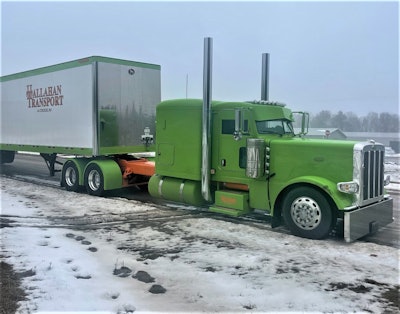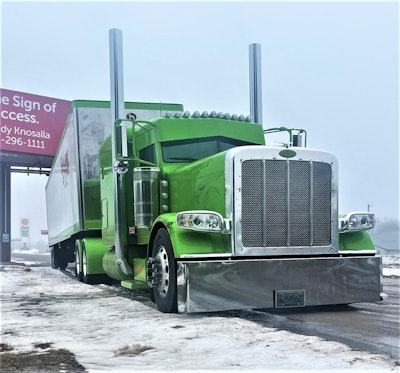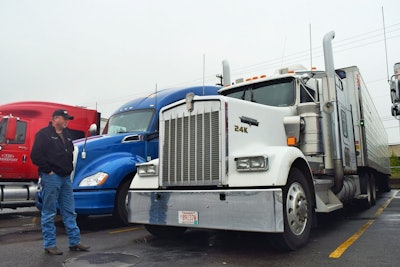Winter is here and with it, snow on the ground and dangerous driving conditions across much of the U.S. north. With the recent rise of nuclear verdicts, a recent 100-car pile up and a 110-year sentence for a relatively inexperienced driver who lost control of his vehicle coming down the other side of a steep grade, it's never been more important for drivers to be informed about the risks of the job and to take appropriate action.
There's no end to guides on how to best handle winter driving conditions from a maintenance, business, and behind-the-wheel perspective. Yet there's also no substitute for hard-won education through experience. Overdrive spoke to three owners with plenty of that in the northern-tier states on their top strategies to stay safe, profitable, and in their lanes while the days remain short and cold.
Ultimately, winter driving represents a danger added to an already tough job. Here experienced drivers share their best tips on how to handle the snow and ice, and perhaps most importantly, when to bow out of a too-dangerous situation.
How to drive in icy conditions
Thomas Remington, an owner-op hauling mostly flatbed loads in a newly acquired 1987 Peterbilt 379 flat top, has "never made any major missteps" in winter conditions. Remington, based in Iowa, has seen his share of snow and ice and recommends a few "common sense" best practices that might not be as common as they should be.

"Always keep an eye on the tire pressure and do it when it’s cold, not when it’s normal out," said Remington. That applies year-round, of course, "but that fist cold, you’re gonna lose anywhere between 10-15 PSI of tire pressure."
Furthermore, expect the unexpected, said Remington. "Keep at least one extra fuel filter in the truck, somewhere it’s warm, not in an outside tool box."
Before even getting to the actual driving component of winter preparedness, Remington said the best start is to "know your damn equipment, what it's capable of and what it's not. What it's like when it's loaded and when it's not, because every different trailer configuration is gonna handle things a bit differently."
When it comes time to actually hit the road, the best offense against accidents is a good defense, Remington said.
 Thomas Remington (left, with beard) and several friends made among drivers at the Love's in Wamsutter, Wyoming, back last winter. The group was making the best of I-80's closure due to high winds and winter weather at the time, with a parking-lot feast for the ages.
Thomas Remington (left, with beard) and several friends made among drivers at the Love's in Wamsutter, Wyoming, back last winter. The group was making the best of I-80's closure due to high winds and winter weather at the time, with a parking-lot feast for the ages.
Remington agreed with other sources that drivers will be at the mercy of traffic in poor conditions, and there's nothing to do but accept conditions as they are, rather than trying to force some opportunity.
"The flow of the traffic is a big deal," he said. "If you ever notice there’s groups of vehicles because people aren’t smart enough to space themselves. You can’t try to race and cut them off. So your head needs to be on a swivel. Chances are, if you’re in congested traffic for a while it’s only going to last for a little while. Don’t heavily brake. People aren't going to cut you off in bad conditions, so keep the space."
Remington, who describes himself as a chef who happens to drive OTR, also recommended his famous chili dog mac and cheese, cream of chicken over mashed potatoes, or a chicken and rice soup to "stick to your ribs" while on the road. He suggested drivers keep a mini-fridge full of supplies in case they have to pull over.
[Related: Peer inside this owner-op's in-cab kitchen, equipped for versatility]
Getting winter-driving experience
 "Now remember this is a show truck that most people would see and say this truck doesn't work," said Hallahan. "The truth is it does work everyday rain, sleet, snow or ice its rolling getting dirty. But come show time it won't have a spec of dirt on it, in it, or under it."
"Now remember this is a show truck that most people would see and say this truck doesn't work," said Hallahan. "The truth is it does work everyday rain, sleet, snow or ice its rolling getting dirty. But come show time it won't have a spec of dirt on it, in it, or under it."
Any online guide can provide basic information about how to handle sliding across the ice. The concept is basic and widely known: Don't counter-steer, and definitely don't try to correct a swerving truck by hitting the throttle.
But the ability to keep a cool head when there's ice on the ground and your loaded trailer feels like it's drifting separates experienced drivers from rookies.
Robert Hallahan, a small-fleet owner based out of La Crosse, Wisconsin, among this year's Small Fleet Champ finalists, learned how to drive on the snow from a young age, and says he won't hire drivers with less than ten years under their belt or no experience in the snow.
"If someone's from Florida and has never driven in the winter, we're not going to be able to hire them," said Hallahan. "I learned 30 years ago. I was born and raised in the north. From when I was 14 we started driving in the snow. My mom and dad took us out in the snow before we had our driver's licenses and did donuts in parking lots."
Hallahan says that, these days, corporations don't like the idea of letting student drivers swerve around their icy parking lots, so the local families have taken to teaching their kids to drive on frozen lakes and rivers. "It's the only place nobody can sue you," he said.
 Hallahan's rig, one of eight in his small fleet, is a 2021 Peterbilt 389, nicknamed "Joke's on You." See plenty more views of it via this video and story, penned after the unit was named Limited Mileage champ in Overdrive's 2021 Pride & Polish competition.
Hallahan's rig, one of eight in his small fleet, is a 2021 Peterbilt 389, nicknamed "Joke's on You." See plenty more views of it via this video and story, penned after the unit was named Limited Mileage champ in Overdrive's 2021 Pride & Polish competition.
As far as maintenance goes, Hallahan doesn't believe in oil-coating trucks, but instead says to wash them all the time. "There are a few products out there that people are spraying on now [that are] supposed to protect your frame, but we stick to washing the truck religiously. Our trucks are spotless. It is bad up here. They spray calcium chloride on the road. Right after they spray it, it gets everywhere -- in the wiring harnesses, everywhere. We go in the shop and get all that off the truck and the wiring immediately."
But even Hallahan, with all his experience and upkeep, sometimes has to handle a skid.
"It doesn’t matter what way you’re skidding, always point your steering wheel where you want to go," he said. "Once you try to counteract it, that’s where you go in a ditch. The truck is always going to follow your steer tires. It doesn't matter if it's a 90-degree slide, if you’re steer tires are heading that way, that's where the truck will go. Don't correct a slide and always point the wheel toward your object."
Hallahan may have ice in his veins when it comes to dangerous winter driving, but he said that his experience has led him to caution against taking on extreme weather conditions.
"The older I get the more I don’t like to drive in the snow," he said. "We get out there, eight or nine inches of snow. Any more than that, if it starts snowing just pull over and go to bed. To be honest I’d rather my drivers pull over than drive in it. If the weather’s bad, it’s too much of a risk now. If I know the weather is bad, I won’t book the load.
"All it takes is one person to make one mistake and you’re gonna lose your authority and get sued for more than you’re worth. It's not worth it and you're better off turning a load down and parking a truck for a day than get put out of business because someone needed a box of eggs."
When to bail on a load, and possibly save a life
Reading a collection of tips from Hallahan and Remington, or hearing a lifetime's worth of stories from other drivers, won't turn you into a pro in the snow. But the advice from Howard Salmon, a owner-op from Northern California with long experience negotiating Western mountain passes and coast-to-coast routes across the top half of the country, might just keep you out of harm's way.
"Many years ago they had the horse and buggy," said Salmon. "Then they came out with the car." At night, you can't see, so: "They added candles, and then headlights. They enhanced driving to have something to get them out of a bad situation. Now they come up with tire chains, another thing designed to get you out of a bad situation."
Yet Salmon's ultimate recommendation echoes Hallahan's final thoughts above: "What I don't understand is, why put yourself into a bad situation" to begin with? "You don't need to drive in dangerous conditions. Just pull over and go to bed."
 Howard Salmon and his long-running 1999 Kenworth W9.
Howard Salmon and his long-running 1999 Kenworth W9.
"I’ve avoided most every bit of it," Salmon said about winter driving. "I park normally right after Christmas or before. I park and don’t go out until April. I will avoid the winter. Because I can. If you don’t feel safe enough as a company driver, let your boss know, don't be afraid."
Ultimately, the best advice for truckers on the ice might not be any heroic moves to reverse a slide or some tool like chains, but to accept that sometimes it's best to simply not get into a dangerous situation.
"Don’t be afraid to talk to your dispatch," said Salmon. "If dispatch says you have to go there, go above him and talk to the boss. I don't think they can fire you for trying to be safe for the company, just say this is not something I want to put myself into."
[Related: Are truckers protected from retaliation for refusing to drive in bad weather?]
Salmon gave the example of a load he was offered heading to Portland, Oregon.
"I looked at the weather up" on the route in Cabbage Hill, or "Deadman Pass," as it's sometimes known, he said. "It said snow Tuesday, Wednesday, Thursday, Friday, Saturday and Sunday and I was supposed to haul on Thursday.
"Do you want me to go ahead and get to that mountain and try to go down a switchback road with little windy turns? They have drop offs. You slide off, you’re going down a mountain. I told my broker, 'I don’t think I’d even be out of there until Saturday, so let's change it.' The brokers are willing to change if you feel in danger. They don’t want you going somewhere that’s bad."
Salmon has put 2.5 million miles on his truck, and 4 million accident-free miles overall. His secret? Not being afraid to admit when he's afraid. "Don’t just take it," he said. "Question your load, question your route. If something is going to bother you, don’t be afraid to say it."
[Related: Cracks in the System: Blowing the whistle on coercion]









